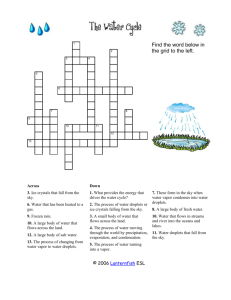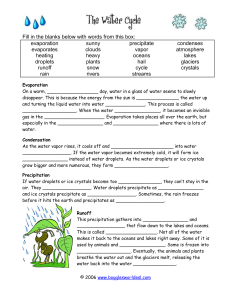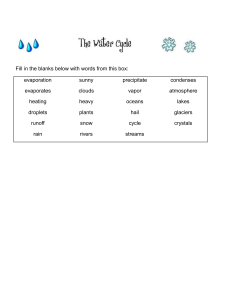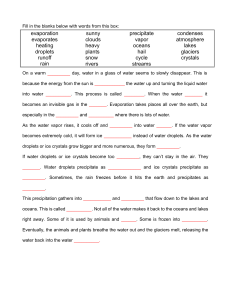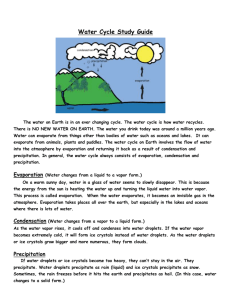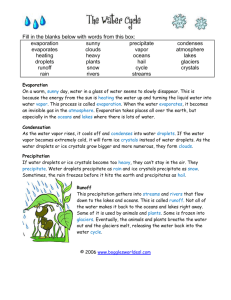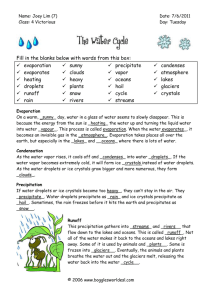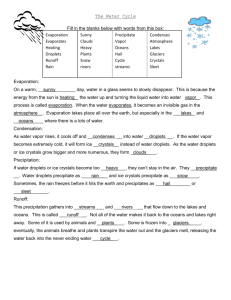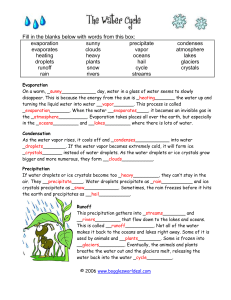SNC1P0 The Water Cycle Package
advertisement
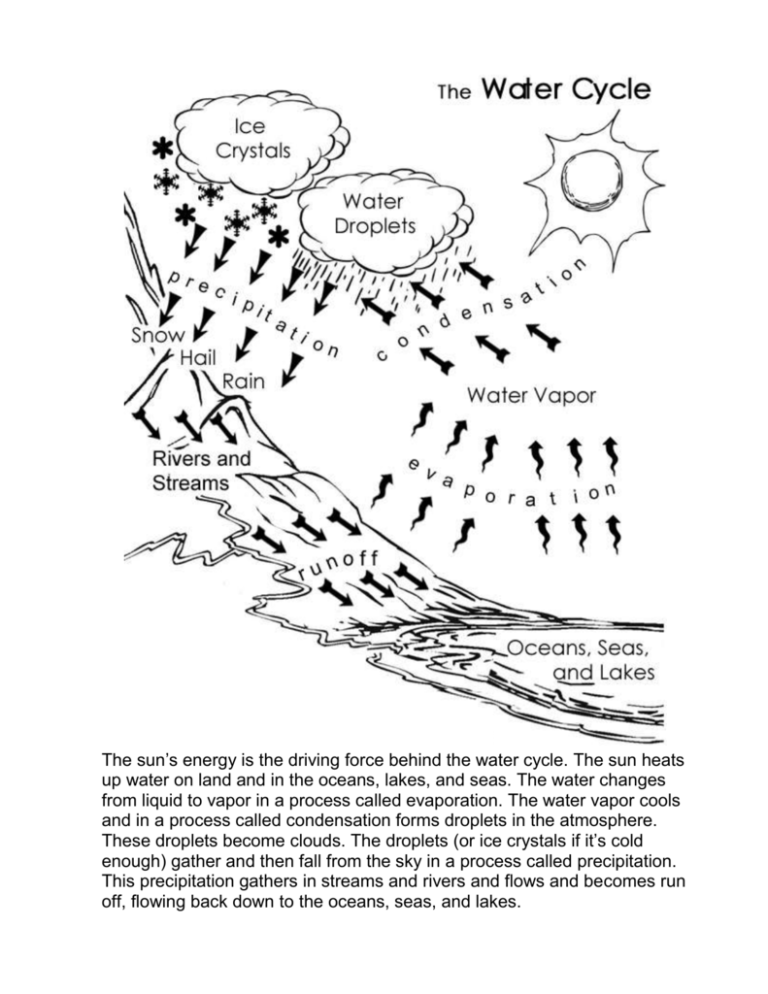
The sun’s energy is the driving force behind the water cycle. The sun heats up water on land and in the oceans, lakes, and seas. The water changes from liquid to vapor in a process called evaporation. The water vapor cools and in a process called condensation forms droplets in the atmosphere. These droplets become clouds. The droplets (or ice crystals if it’s cold enough) gather and then fall from the sky in a process called precipitation. This precipitation gathers in streams and rivers and flows and becomes run off, flowing back down to the oceans, seas, and lakes. Find the word below in the grid to the left. cloud condensation energy evaporation hail ice crystal lake ocean precipitation rain river runoff sea snow stream sun water cycle water droplet water vapor wind 1 Find the word below in the grid to the left. 2 3 4 5 6 7 8 9 10 11 12 13 Across Down 3. Ice crystals that fall from the sky. 1. What provides the energy that drives the water cycle? 6. Water that has been heated to a gas. 2. The process of water droplets or ice crystals falling from the sky. 9. Frozen rain. 3. A small body of water that flows across the land. 10. A large body of water that flows across the land. 12. A large body of salt water. 13. The process of changing from water vapor to water droplets. 4. The process of water moving through the world by precipitation, evaporation, and condensation. 5. The process of water turning into a vapor. 7. These form in the sky when water vapor condenses into water droplets. 8. A large body of fresh water. 10. Water that flows in streams and river into the oceans and lakes. 11. Water droplets that fall from the sky. Fill in the blanks below with words from this box: evaporation sunny precipitate evaporates clouds vapor heating heavy oceans droplets plants hail runoff snow cycle rain rivers streams condenses atmosphere lakes glaciers crystals Evaporation On a warm, __________________ day, water in a glass of water seems to slowly disappear. This is because the energy from the sun is _______________ the water up and turning the liquid water into water ______________. This process is called ___________________. When the water ________________, it becomes an invisible gas in the _____________________. Evaporation takes places all over the earth, but especially in the ________________ and ________________ where there is lots of water. Condensation As the water vapor rises, it cools off and ______________________ into water _________________. If the water vapor becomes extremely cold, it will form ice ________________ instead of water droplets. As the water droplets or ice crystals grow bigger and more numerous, they form ___________________. Precipitation If water droplets or ice crystals become too _______________, they can’t stay in the air. They _________________. Water droplets precipitate as ________________ and ice crystals precipitate as _________________. Sometimes, the rain freezes before it hits the earth and precipitates as _________________. Runoff This precipitation gathers into ________________ and _________________ that flow down to the lakes and oceans. This is called __________________. Not all of the water makes it back to the oceans and lakes right away. Some of it is used by animals and ________________. Some is frozen into ___________________. Eventually, the animals and plants breathe the water out and the glaciers melt, releasing the water back into the water _______________. We can find water in many places and in many forms. Water can be solid, liquid or a gaseous. Use the three words, solid, liquid, and gaseous, to define all of these other water words. Another way to say ‘solid water’ is ‘frozen water’. An ice cube Rain Steam A snowflake A river Frost Dew An icicle Hail A stream Vapor Ice A glacier An iceberg A waterfall There are bodies of water all over our planet. Describe the different bodies of water using the words small, large, fresh, salt, deep, shallow, protected, still, and flowing. Try to use at least two adjectives per description. A lake A sea A river A pond A stream An ocean A puddle A bay A creek A cove An inlet A lagoon An oasis A tide pool
